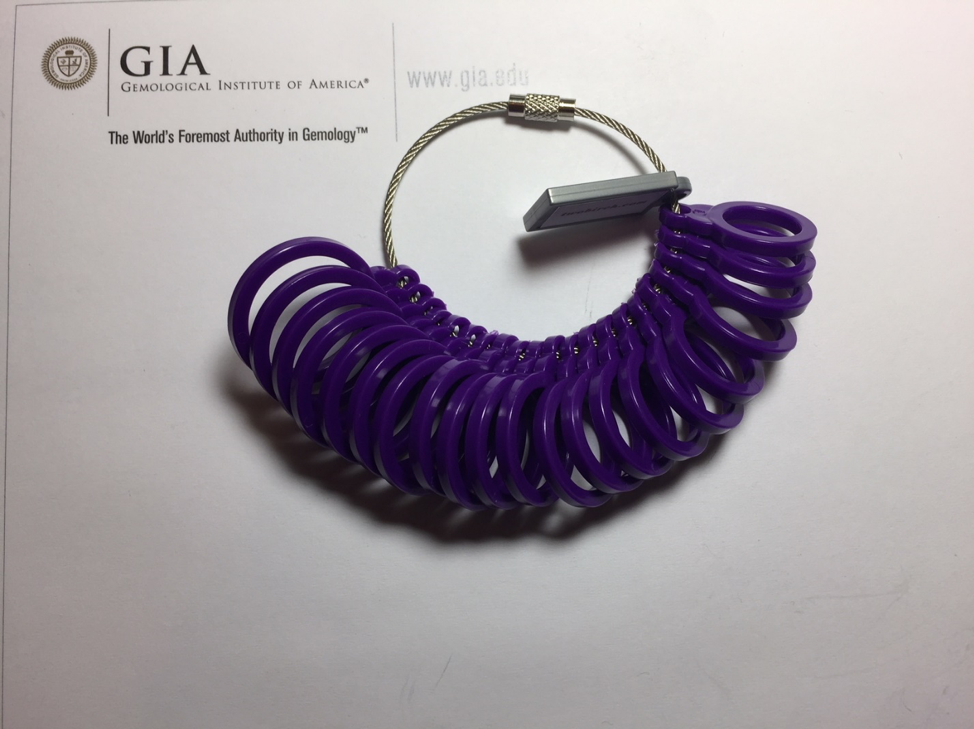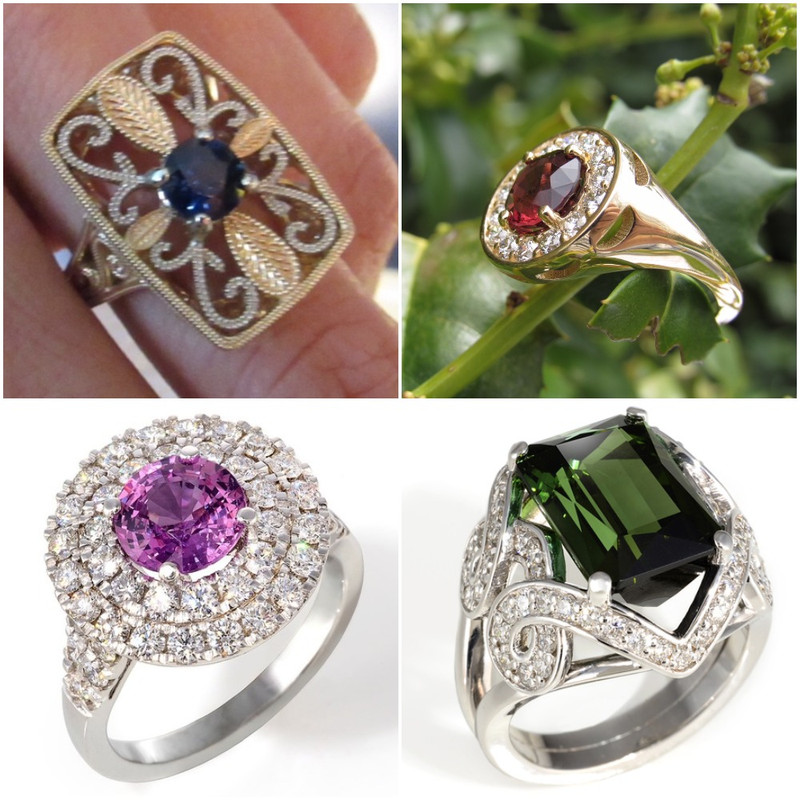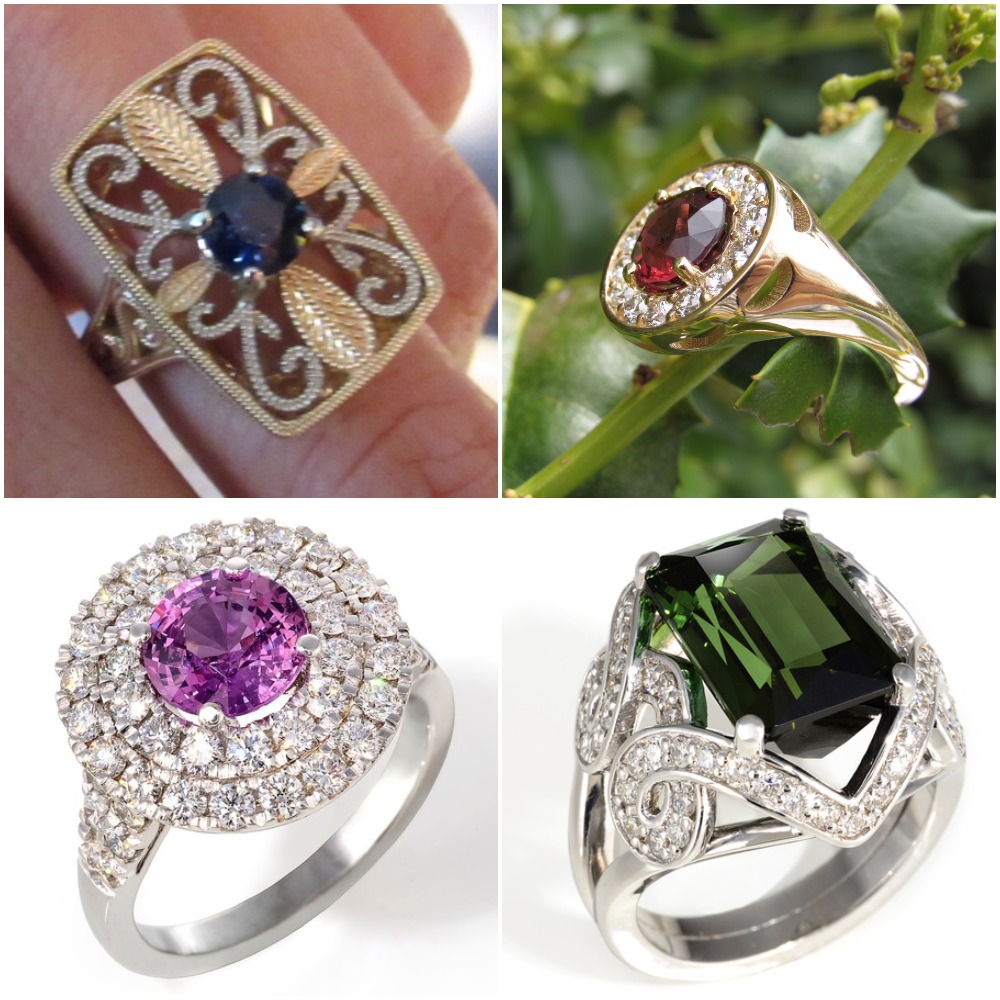You’re going to learn in this blog that the best way to start is by measuring your ring size using ring gauges, as pictured towards the middle of the blog. If you’re located in the US, we are happy to provide you with a complimentary set of these ring gauges. Just email info@100eastfinejewlery.com or call 812-202-2143. We’re happy to send you a set.
Most woman’s rings sold in the US are between sizes 3 and 9, with the average being 6 to 7. Each 100 East Fine Jewelry ring is one-of-a-kind and is manufactured in a single size, either size 6 ½ or 7. Resizing is possible, but there is a limit to how far any ring can effectively be resized. While our rings fit a significant portion of the population, they will not fit everyone. This post is designed to:
- Provide you with information about ring sizes, in general – what they mean, how they’re determined and what affects your ring size
- Help you determine if a ring in our inventory that interests you is a realistic fit. Every person is different and we can’t guarantee that following these instructions provides a perfect fit. We do, however, hope to reduce the uncertainty.
A properly sized ring should pass over the knuckle onto the finger, stay there without falling off and fit comfortably without excessive movement and spinning. Simply put, the ring should go on easy, but come off hard. When taking it off, the ring should resist slightly; taking as much as 2-3 seconds to get back over your knuckle. This prevents your expensive new ring from falling off, while also avoiding busting your knuckles when you do need to take it off.
What is ring size?
Just as shoe size is a way of representing the length and width of your foot, US ring size is a scale representing specific finger measurements. The ring scale represents the measure of the inner diameter and inner circumference of the finger opening in the ring’s band. For example, in the US, when a woman’s ring size is described as a 6, that means the band’s inner diameter measures 16.5 mm and its inner circumference measures 51.9 mm. (These measures can also be expressed in inches.) Ring size scales are different around the world; some are based on numbers, like the US system; others use letters and numbers (UK system).
Is my ring size the same for all rings I wear?
No. Your ring size can vary depending on the ring’s design. It’s possible your ring size could be 7 for one style, 6 ½ for another or 7 ½ or larger for a third style.
For example, the wider the ring’s band, the tighter it will feel on your finger. To compensate, the band needs to be sized slightly larger to fit comfortably. Our rule of thumb is that if the ring’s band is 4 mm or wider, ½ size should be added to your measured size for every millimeter of band width beyond 4 mm. If the band is less than 4 mm wide, we don’t change your measured size.
On the other hand, if the ring’s design is such that the band has an open space (isn’t continuous) because the setting is elevated, less metal is in contact with the finger. In order to fit comfortably, the ring should be sized slightly smaller than your measured size.
Can I use some of the techniques I’ve found on the internet to determine my ring size?
There are any number of do-it-yourself techniques found on the internet for determining ring size that we don’t recommend. These include:
- Wrapping string, dental floss or paper around your finger and measuring with a ruler
- Measuring a ring that fits properly with a ring sizing tool printed off the internet. One such tool is a paper covered with different sized circles representing various ring sizes. The ring band is laid on the circles for you to match the hole in the ring band with one of the circles.
- Base ring size on shoe size. If you wear a 7 shoe size, your ring size is a 7, etc.
- Use a ruler to measure the finger opening diameter of a ring that fits well.
The problem with these techniques is they are either just plain wrong or lack the needed precision to be reliable. If you’ve ever had a ring sized, you know that ½ size difference on a ring can make a huge difference in how the ring fits. Consider the differences in band diameter and circumference between a ring sized as a 6 versus a 6 ½.
| Diameter | Difference | Circumference | Difference | |
| Size 6 | 16.5 mm | ------------- | 51.9 mm | -------------- |
| Size 6 ½ | 16.9 mm | 0.4 mm | 53.1 mm | 1.2 mm |
You better have a steady hand and an eagle eye to distinguish differences that small. 0.4 mm is roughly 1/64 th of an inch and 1.2 mm is roughly 1/22 nd of an inch. So, if your string stretches slightly, your paper moves just a touch or you can’t clearly tell where the circle ends and a shadow begins, your measurement can easily be ½ to 1 size off on your ring size estimate. We feel using ring gauges and the information provided on our website is much more accurate.
I already know my ring size. Isn’t that good enough?
Maybe. Under some circumstances, using a known ring size is unreliable for sizing a new ring. First, refer to the question, Is My Ring Size the Same for All Rings I Wear? . Subtle design differences between your existing and a different style ring can yield different ring sizes.
Secondly, physical changes to your body over time, such as weight loss or gain, pregnancy, injury to or arthritis of the knuckles can change finger diameter or circumference, along with your ring size. If you rarely take the ring off, you may not even realize your finger and ring sizes have changed.
Lastly, your ring with the known size must fit on the same finger and hand where the new ring will be worn. You obviously wouldn’t measure your pinky finger for a ring to be worn on your ring finger. You may not be aware, but the same finger on opposite hands differ slightly in size. A finger on your dominant hand is typically slightly larger than the same finger on your non-dominant hand.
So, it’s possible the known size of a ring you own will work on another ring you’re considering, but for some of the reasons listed above, it might not. When purchasing one of our rings, we strongly advise you to follow the steps we lay out below, even if you think you know your ring size. There's an old carpenter's saying that applies here; "Measure twice and cut once!"
HOW TO DETERMINE IF OUR RING WILL FIT YOU

STEP 1: Measure Your Finger with a Plastic Ring Gauge
You say, ‘Great, I don’t have a plastic ring gauge.’ We can cure that. If you’re located in the US, 100 East Fine Jewelry will send you a set of plastic ring gauges like those seen above. There is no purchase obligation. They range from size 3 to 13, in ½ size increments. Each gauge is about 2 mm wide, representing a narrow band size. Just email info@100eastfinejewelry.com or call 812-202-2143 and we’ll send them by regular mail. You should receive them in about a week. If you need them sooner, we can send them via expedited mail, but will charge you the shipping cost.
When is the best time to measure ring size?
Your finger size can vary slightly over a reasonably short period of time as a result of:
- Time of day - Fingers tend to be a slightly smaller diameter in the mornings and larger in the evenings
- Temperature – Fingers tend to be smaller diameter in cold weather and larger in warm weather
- Water retention – An abnormally salty diet can cause you to retain water and your fingers to swell.
- Strenuous exercise – Your fingers may temporarily swell after strenuous exercise.
Avoid measuring your ring size when you’re experiencing temporary water retention or shortly after strenuous exercise. Measure your fingers near the end of the day and when they’re at room temperature. You should measure your ring size 3-4 times under these conditions.
Again, pick the gauge which goes on easily and comes off harder, taking 2-3 seconds to get off over the knuckle.
Other tips when using the plastic ring gauges
- Always measure the finger on the hand where the ring will be worn.
- Even though our ring gauges come in ½ size increments, our jewelers can size a ring in ¼ size increments. You may want to extrapolate between ½ sizes. For example, if a size 6 feels slightly tight and 6 ½ slightly loose, you may want to select 6 ¼. If you’re not sure, it’s always better to estimate larger than too small. In this example, use 6 ½.
- After the gauge is in the proper position on your finger, relax your hand. If the finger bulges on either side of the gauge, the size is too small.
- If you have larger sized knuckles due to natural bone structure, arthritis or injury, let us know. There are special means to accommodate most of those situations.
STEP 2: Go to Our Website’s Product Detail Page to Determine if Our Ring Will Fit You.
Congratulations! In Step 1, you determined your ring size for a ring with a continuous band (no gaps where the setting is raised) and a band width under 4 mm. The next step is to decide if the specific 100 East ring you’re interested in will fit you.
First, navigate our website to the Product Detail sheet for the ring that interests you. Do this by hovering over or touching the ring’s picture to bring up View Details. Click it to get to Product Detail. Scroll down the Description section of the page to RING INFORMATION, which provides an overview of the ring including metal type, as-is ring size, etc. Look for:
- Adjustment to Your Ring Size Based on This Ring’s Design:
This field contains comments such as: add ½ size, subtract ½ size, no changes, etc. Using the ring size you measured in Step 1, follow the instructions in ‘Adjustment to Your Ring Size Based on This Ring’s Design’. You now have the ring size that particular ring must be to fit you properly. For example, let’s say in Step 1 you measured your ring size at 6 ½ and you’re interested in 2 of our rings. According to the Product Detail sheets for the 2 rings, the following instructions are provided:
- Ring A – Adjustment to Your Ring Size Based on This Ring’s Design: add ½ size
- Ring B – Adjustment to Your Ring Size Based on This Ring’s Design: no change
This tells you:
- Ring A, to fit you properly, should be sized as a 7 (6 ½ + ½).
- Ring B, to fit you properly, should be sized as a 6 ½ (6 ½ and no change).
Next, compare this size to the following entries for each ring:
- As-is ring size:
- Resize potential:
Again, carrying on with the above example, let’s say the information on these 2 rings is:
- Ring A
- As-is ring size: 6 ½
- Resize potential: 5 to 8
- Ring B
- As-is ring size: 7
- Resize potential: 6 to 8
Based on this, neither ring will fit you as-is out of our inventory, but each on can be resized to fit you:
- Ring A, to fit you properly, should be size 7. Its as-is size is 6 ½, but it can be resized down to 5 and up to 8. So, this ring can be resized ½ size larger (from 6 ½ to 7) to fit you.
- Ring B, to fit you properly, should be size 6 ½. Its as-is size is 7, but it can be resized down to 6 and up to 8. So, this ring can resized ½ size smaller (from 7 to 6 ½) to fit you.
How are 100 East rings resized?
To resize, the band is cut and a piece of the metal is either removed or added to decrease or increase size. Once this step is complete, the band is re-welded and re-polished.
Once you receive a newly sized ring, wear it for a few days before deciding it’s too large or small. A different ring style or band width may cause the ring to feel odd at first even if the size is correct.
What if our ring can’t be resized to fit you?
If you’re really in love with that particular style, and we can’t resize the one we have in inventory, ask us if we can make a similar ring for you in your size.
Buying a ring from 100 East Fine Jewelry.
The safest course of action when buying a ring from us is to follow the steps laid out earlier:
- Request a set of ring size gauges from us
- Calculate ring size using the gauges; Step 1
- Determine the ring size for the specific ring you’re considering; Step 2
- If it’s a match, then buy the ring.
Buying a ring as a surprise?
We don’t recommend resizing a ring before presenting it as a surprise gift, even if you or a close relative or friend think you know her ring size. The surprise will not be diminished if she can’t immediately wear the ring and unfortunately, it very likely could result in a second resizing before she is able to wear the ring or worse, the ring may not fit her at all. Instead, we can send you the ring and gauges, you can surprise her and then she can use the gauges and the above process to determine if the ring will really fit.
However, having a reasonable idea of her ring size either directly or indirectly through a friend or relative might be beneficial, IF the information is reasonably accurate. You can compare the size you have to the resize capability of the ring to see if there is overlap. For example, our ring can be resized to between 5 ½ and 7 ½ and you believe her ring size is:
- 6, There is a good probability it can fit. Commit.
- 5, It’s possible the ring will fit and may be worth committing to.
- 4, It’s unlikely this ring will fit. You have 3 choices; hope you’re wrong and commit to it as a surprise gift, move on to another ring or talk to us about making a similar ring in her size.


